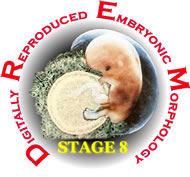

| Opening Screen | 3D Models | Help / Instructions |
| Browse Sections | Flythrough Animations | Credits |
| Download Section Images |
 |
||
|
Stage 8 embryos have a greatest length of 0.5 to 1.5 mm and an estimated postfertilization age of 23 days. The embryos are still in the presomite period. The neural folds, the notochordal canal, and the gastrulation (primitive) node and pit are typically present. The stage is represented in the DREM databases by Carnegie embryo #10157 that has been given a grade of excellent. The embryo is estimated to have an age of 23 postfertilization days. The embryonic disc is ovoid in shape when viewed from the dorsal aspect. Primary neurulation has begun and although a primordial head-fold is not yet evident a primordial tail-fold is present. A transverse groove, that is likely a fixation artifact, is present in the caudal part of the neural plate. The gastrulation (primitive) node and notocordal canal could not be identified in this specimen. This specimen was prepared for microscopic examination in 1967. It was fixed in formol, embedded in paraffin, and serially sectioned transverse to the long axis. The section thickness was not recorded but we estimate it to have been 5 - 8 microns. The sections were mounted on 62 small glass slides and stained with cason. There are 225 sections through the embryo and adjacent membranes of which 121 are labeled and can be viewed at four levels of magnification in the browser. The morphology of this embryo has not been documented in the literature. There are no known photographs of the embryo before it was sectioned and the Carnegie collection has no reconstructions of the embryo. The sections have been digitally restored and labeled, and can be viewed at four magnifications. Several 3D reconstructions have been produced from the aligned sections. Animations of 3D reconstructions of the embryo surface and the internal anatomy together with flythrough animations of the aligned sections are also included on the disks. For anyone who wishes to use them for other reconstructions, research or presentations, all of the original section images are available as individual .jpg files or as zip files. Instructions for using the disks can be found by going to the Instructions section from the opening screen. |
||